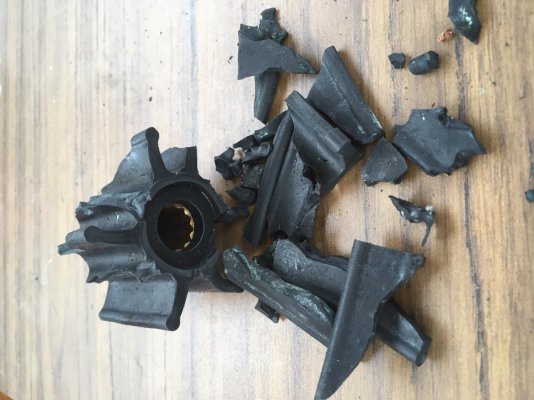Fussbudget,
I don't want to say that an airlock wasn't the problem. You are saying it is, and I sure have no reason to disbelieve you. And, I sure don't know how your plumbing runs.
But, I had two 6.354MGTs in my last boat and a 4.107 powering the genset, and have two 6.354Ms in my present boat. I have serviced all sorts of parts of those systems, getting a ton of air into it. It has never had a problem blowing it all out. I just try to make sure the impellers don't run dry without lubrication, because I'm afraid of wrecking them. When I asked my mechanic about air locking when he was working on things, he told me to go check the water in the back -- but they normally just blew most of the air right out and all of it within a few minutes.
A lot of friends have boats that "run hot" if they run at a high throttle. In these situation their temp gauges will slowly climb until they back down. One thing that struck me about my old boat (I haven't done an extended, extended test on my new boat) is that it could cruise WOT indefinitely without running any hotter.
I like to run very heavy to WOT for a few minutes each trip on the way back just to see how it does and stress test things. On the old boat with the turbos, I wanted them to get to run hot. One day on my old boat I was coming back and went WOT for the last few minutes, then we decided to extend the trip and go somewhere for lunch. In all of the discussion and turning around, &c, I forgot I was at WOT. I ran almost an hour that way. The engines were still at the same temperature as at normal cruise (I can't say the same for the EGT....or even the engine room)
Admittedly, on that boat I had all new coolers and exchangers and hoses and rebuilt raw water pumps. But, in well designed and built systems, when things are all clean and running well, they don't run hot. I know that wasn't a complaint of yours, just an observation of mine.
I guess what I'm saying is you might want to keep an eye on things. There might be some other inefficiency in the system that result in it not having as much ummf to drive out that air, e.g. more impeller or zinc bits or trash or scaling, somewhere else in the system that is cutting into its efficiency. So, there might be more going on than you fixed and, even if it doesn't affect you at a gentle cruise right now -- it might affect you if you try to run harder get some other junk building up, maybe in the same place.


